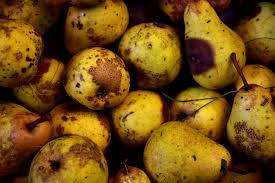As the growing season wraps up, the natural rhythms of the garden continue to influence our menus. Vegetables harvested and stored throughout the year may need attention as they age. Potatoes might begin sprouting, and winter squash can develop spots that signal it’s time to eat them. To avoid spoilage and wasted food, it’s crucial to regularly inspect your stored produce.
Here’s a guide to help you identify and prevent spoilage in your stored garden crops:
Sniffing Out Spoilage
The saying “one bad apple spoils the bunch” is spot-on. Decay-causing microorganisms can spread rapidly from one piece of fruit to others, especially when stored together. This is true for not only apples but also potatoes, onions, and garlic. While apples may rot without much noticeable smell, rotting potatoes or onions will have a strong, unpleasant odor. If you detect any foul smells, it’s best to remove the spoiled produce before the problem worsens.

Sprouting Potatoes and Onions
If your potatoes or onions have started sprouting, it’s a sign that they’ve begun to break dormancy. Potatoes’ dormancy can be influenced by their variety, growing conditions, and curing methods. For example, heating a cool basement can trigger sprouting. As soon as you spot sprouts, use up the affected produce, as sprouting indicates it’s time to eat them before they spoil further.
Winter Squash Troubles
Some winter squash varieties, like those with very hard rinds, can last through the winter in good condition. However, squash do not always follow storage rules. Squash such as kabocha or pumpkins can begin to spoil from the inside out when stored in warm conditions. If you hear a wet sloshing sound when you shake a pumpkin or squash, it has likely gone bad and should be composted. Also, watch for soft spots on the rind, which signal the beginning of rot.

Canned Produce: Troubleshooting Seal Failures
When canning fruits and vegetables, it’s crucial to ensure the jars have sealed properly. While jars may appear sealed after processing, some may lose their seal or develop issues later, such as mold or discoloration. Always inspect your canned goods after cooling and before storage. Look for cracks, chips, or bulges in the jar rims, as these flaws are often responsible for failed seals. If a jar’s seal is compromised, discard the contents and recycle the jar.
Organizing Chilled and Frozen Produce
While cleaning out the refrigerator or freezer is never a fun task, neglecting it can lead to wasted food. Shriveling carrots and wilting radishes can easily get lost in the depths of the fridge. To avoid this, store vegetables in clear plastic bags to help you identify them quickly. Beets, however, are notorious for hiding themselves, so check thoroughly.
Your freezer can also become disorganized, which can lead to broken bags and compromised food quality. Organize your freezer by keeping fruits and vegetables on separate shelves, and consider using small bins for better organization. This will help prevent unnecessary damage and ensure everything stays fresh.

Maximizing the Shelf Life of Stored Produce
As the season transitions, it’s important to “shop your own store first” and prioritize using up your stored vegetables. Regularly check on their condition, and use any items that are nearing their expiration or are showing signs of spoilage. By staying on top of your stored produce, you can prevent waste and continue to enjoy homegrown meals long into the winter.
By keeping a close eye on your stored produce and maintaining a regular inspection routine, you can ensure that your garden harvest lasts as long as possible without spoiling.
